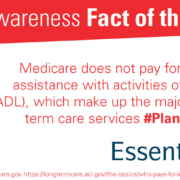Community Living Assistance Services and Support (CLASS) Act – Long Term Care University

Long Term Care University – Question of the Month – 07/15/11
By Aaron Skloff, AIF, CFA, MBA
Q: Can you explain what the Community Living Assistance Services and Support (CLASS) Act is, as well as the advantages and disadvantages of the program?
The Problem – The Holy Grail with Lots of Holes
The Community Living Assistance Services and Support (CLASS) Act was designed by the late Senator Edward Kennedy as a voluntary insurance program to help adults age 18 and over with disabilities pay for long term services and supports. In March 2010, President Barack Obama signed into law the Patient Protection and Affordable Care Act, establishing the CLASS program. Unfortunately, the CLASS Act’s 2013 expected implementation presents as many problems as it does solutions.
Click Here for Your Long Term Care Insurance Quotes

The Solution – Looking Before Leaping Into the CLASS Act
According to an April 29, 2011 article in The New York Times:
“In recent months, Kathleen Sebelius, the secretary of health and human services, has said that it will be difficult to make the offering both affordable and actuarially sound without some alterations.”
“Also, Ms. Sebelius or her successor could decide to shut down the program before it pays a dollar of claims and return any premium money to participants.”
“Plenty of politicians are furious about the fact that something like this became law without the long-term numbers adding up.”
The CLASS program will be available on a guaranteed-issue basis to all actively working individuals who are at least 18 years old and not already receiving care in a facility. Since there are no underwriting requirements there be will be a significant number of high risk and/or disabled enrollees. This presents a good opportunity for enrollees with poor health and a tremendous liability for enrollees with average or good health. Healthy enrollees will likely need to subsidize enrollees with poor health, as premiums are likely to rise when those with poor health require long term care.
Before participants can even apply for benefits, they need to pay premiums into the program for five years and must earn wages for at least three of those five years. Thus, participants may need to pay for care out-of-pocket until the five-year vesting period is satisfied. Obviously, retirees and those close to retirement cannot even participate in the CLASS program. Employers can choose whether or not to offer the voluntary program.
The CLASS program’s benefits, which can be as low as $50 day per day, are inadequate for most long term care settings. The median cost of long term care in the U.S. in 2010 ranged from $152 per day at home to $206 per day in a nursing home. The median cost of long term care in New York State in 2010 ranged from $170 per day at home to $320 per day in a nursing home.
Unlike many traditional long term care insurance policies, the CLASS program is not approved under Long Term Care Insurance Partnership Programs. Most states’ Long Term Care Partnership Programs allow long term care insurance policyholders to protect their assets from Medicaid on a Dollar for Dollar basis – for every dollar your policy pays in benefits, a dollar of assets is ignored by Medicaid. Some states, including New York, offer 100% Medicaid asset protection through Total Asset Protection – an unlimited amount of assets are ignored by Medicaid.
You can apply for private long term care insurance, whether or not you have earned income. Unlike with the CLASS program, you may be eligible for benefits the day after you purchase your long term care insurance policy – depending upon the elimination period you selected. Since individual long term care insurance policies are underwritten (allowing insurers to deny applicants), most insurers offer spousal/partner discounts and/or good health discounts. These combined discounts can reduce premiums as much as 50%.
Action Step – Do Your Homework before Purchasing Long Term Care Insurance
Understand the advantages and disadvantages of a federal long term care program that has yet to be implemented and could be shut down after it has already been implemented. Remember, you must be working and contributing (not unemployed, retired, disabled, etc.) while you contribute to the federal program. A private long term care insurance policy used in conjunction with or separate from the federal program avoids many of the problems of the federal program.
Aaron Skloff, Accredited Investment Fiduciary (AIF), Chartered Financial Analyst (CFA) charter holder, Master of Business Administration (MBA), is the Chief Executive Officer of Skloff Financial Group, a NJ based Registered Investment Advisory firm. The firm specializes in financial planning and investment management services for high net worth individuals and benefits for small to middle sized companies. He can be contacted at www.skloff.com or 908-464-3060.












